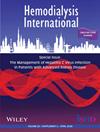Comparing the effectiveness of a blended video plus face-to-face educational program with a face-to-face educational program on quality of life among adolescents undergoing hemodialysis in Palestine
Abstract
Introduction
Hemodialysis is frequently used as a primary treatment for individuals with end-stage kidney disease (ESKD), and it significantly impacts the quality of life in adolescents undergoing this procedure. Providing a hemodialysis education to these patients is a valuable strategy for enhancing their well-being. The aim of the study is to assess the effect of the video-assisted educational program on the quality of life among adolescents undergoing hemodialysis in Palestine.
Methods
This study employed a quasi-experimental design, a pre-test–post-test interventional study, involving a sample of 68 adolescent patients between the ages of 13 and 18 diagnosed with ESKD. The quality of life level was assessed in both groups using an Arabic version of the Pediatric Quality of Life Inventory™ version 3.0 ESKD Module survey. The study was conducted at the dialysis units in four hospitals associated with Augusta Victoria Hospital, An-Najah University Hospital, Palestine Medical Complex/Ramallah, and Beit Jala (Al Housain) Hospital. The study involved providing tailored face-to-face educational sessions with video assistance to the experimental group, while the control group received regular face-to-face education.
Findings
The Generalized Estimating Equation analysis revealed no significant differences in quality of life between the experimental and control groups over time, across pre-test, post-test, and follow-up periods (p ≥ 0.05). However, within the experimental group, there was a significant improvement in total quality of life scores between the pre-test, post-test, and post-test follow-up (p ≤ 0.001), although the difference between the pre-test and follow-up approached significance but was not statistically significant (p = 0.056). In contrast, the control group showed significant differences in quality of life across the pre-test, post-test, and follow-up time points (p ≤ 0.05).
Discussion
Implementing suitable interventions can potentially enhance the quality of life for individuals undergoing hemodialysis. Consequently, we suggest using video-based education as a cost-effective, uncomplicated, and engaging approach for educating hemodialysis patients.

 求助内容:
求助内容: 应助结果提醒方式:
应助结果提醒方式:


